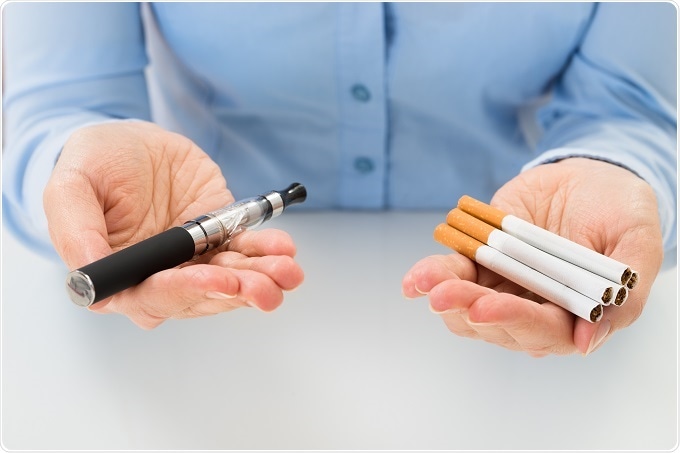Jun 13 2017
A study by chemists at the University of Connecticut (UConn) offers new evidence that e-cigarettes loaded with a nicotine-based liquid are potentially as harmful as unfiltered cigarettes when it comes to causing DNA damage.
 Credit: Andrey_Popov/Shutterstock.com
Credit: Andrey_Popov/Shutterstock.com
The researchers also found that vapor from non-nicotine e-cigarettes caused as much DNA damage as filtered cigarettes, possibly due to the many chemical additives present in e-cigarette vapors. Cellular mutations caused by DNA damage can lead to cancer.
Karteek Kadimisetty, a postdoctoral researcher in UConn's chemistry department and the study's lead author said that the amount of DNA damage caused by e-cigarettes is dependent on the amount of vapor the user inhales, the other additives present, whether nicotine or non-nicotine liquid is used, and other factors.
He added, "From the results of our study, we can conclude that e-cigarettes have as much potential to cause DNA damage as unfiltered regular cigarettes."
Electronic cigarettes are battery-powered devices that heat up liquid and turn it into an aerosol vapor for inhalation. Using e-cigarettes is also called “vaping.” The contents of e-cigarettes, called e-liquid or e-juice, are usually made of propylene glycol, glycerin, nicotine, and flavoring agents such as menthol, cherry, vanilla, or mint. Non-nicotine e-cigarettes are also available.
Electronic cigarettes first appeared on the commercial market in 2004. Since then the popularity of modern e-cigarettes has been steadily increasing. People looking to break their habit of smoking tobacco cigarettes frequently view e-cigarettes as a less toxic alternative. However, how much it contributes to serious health problems and whether they serve as a gateway for future tobacco smokers remains the subject of much debate. The U.S. Food and Drug Administration was prompted to tighten its regulation of e-cigarettes in 2001 due to the growing concerns about the potential health impact of electronic cigarettes.
The scientists at UConn were determined to find whether the chemicals in e-cigarettes could cause damage to human DNA while testing a new electrooptical screening device they developed in their lab. The researchers said the small 3-D printed device is believed to be the first of its kind, capable of quickly detecting DNA damage, or genotoxicity, in environmental samples in the field.
In a small carbon chip, multiple microwells preloaded with reactive human metabolic enzymes and DNA are embedded. The device uses micropumps to push liquid samples across multiple microwells. As the samples drop into the wells, new metabolites that have the potential to cause DNA damage are formed. A camera captures the light generated by the reactions between the metabolites and the DNA. By the light intensity detected in each well, users can see the amount of relative DNA damage a sample produces within 5 min.
Currently, bioassays are used to find the genotoxicity of environmental samples. They may be more comprehensive, yet they are often time-consuming and costly. Lab equipment alone can cost tens of thousands of dollars. The array developed at UConn provides an important initial screening tool for genotoxicity in just minutes. Due to the recent advances in 3-D printing, the chip central to the device is disposable and costs only a dollar to make.
What we developed is very cheap to make, efficient, and can be used by almost anyone,"
James Rusling, the senior researcher on the study
He said similar arrays could be potentially used for quick genotoxic screening during drug development, for monitoring or testing freshwater supplies, and for the early detection of aggressive forms of cancer. Previously, Rusling's lab has created miniature arrays that can detect antibodies to food allergens and cancer biomarker proteins.
In the current study, the researchers extracted samples from e-cigarettes and tobacco cigarettes using an artificial inhalation technique. Cigarettes were connected to a tube that contained a cotton plug. The researchers then used a syringe at the other end of the tube to replicate inhalation. Samples came from the chemicals captured in the cotton.
The team set their test so that 20 puffs of an e-cigarette was roughly equivalent to smoking one tobacco cigarette based on a ratio supported by other research. The team gathered samples at 20, 60, and 100 puffs. Kadimisetty said there are potentially hundreds of chemicals in e-cigarettes that could be contributing to DNA damage, which increases with the number of puffs.
The UConn team targeted three known carcinogenic chemicals found in tobacco cigarettes instead of testing all of them. They then loaded the microwells of the device with specific enzymes that would convert those chemicals into metabolites. If these chemicals were in the sample, the test gave them a reading for genotoxicity. If the chemicals were not present, there would be no reaction.
Kadimisetty said the device is unique in that it converts chemicals into their metabolites during testing, which replicates what happens in the human body. "Some people use e-cigarettes heavily because they think there is no harm," he says. "We wanted to see exactly what might be happening to DNA, and we had the resources in our lab to do that."